Opinion & Analysis
A deep dive into “toe hang” of a putter, and why it matters
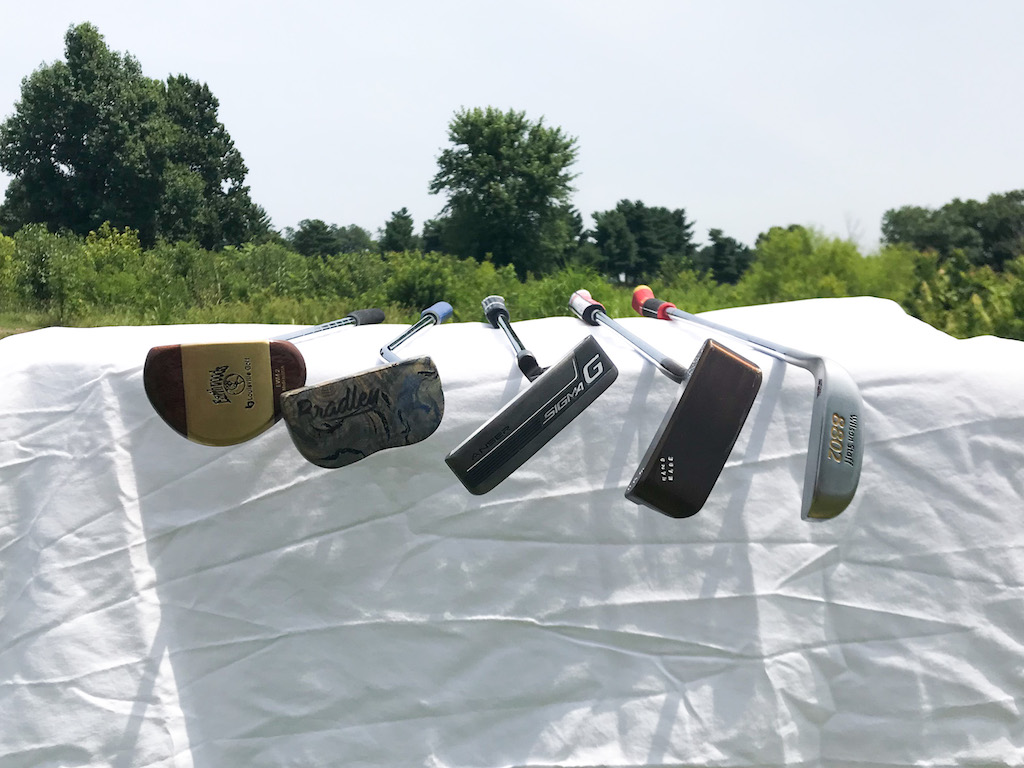
Let’s start with the basics just to be sure everyone is on the same page. When people talk about toe hang (at least in the traditional sense), what exactly are they talking about?
Grab your putter and lay it on a flat surface with the putter head hanging freely off the edge. Now, look at where the toe of your putter is pointing and imagine a clock face is centered on the axis of the shaft. The closer the toe of your putter is to pointing at 6:00, the more toe hang it has. The closer the toe of your putter is to pointing at 9:00 (for a right-handed golfer), the less toe hang it has. If the toe of the putter is pointing directly at 9:00 (where the face is pointing straight up), that is referred to as “face balanced.” If the toe of the putter is pointing at 7:30, that is generally referred to as “1/4 toe hang.” If the toe of the putter is pointing directly at 6:00, that is commonly referred to as “full toe hang.” Generally speaking, the majority of putters will fall on a spectrum somewhere between face balanced and full toe hang.
Of course, there are exceptions to that, but the point of this article will be to address more traditional designs.
What determines Toe Hang?
In technical terms, toe hang is determined by the relationship between the axis of the shaft and the center of gravity of the putter. If the two are perfectly aligned, the result is a face balanced putter. However, as the axis of the putter shaft gets closer to the golfer in relation to the putter’s center of gravity when addressing the golf ball, more toe hang will be the result. What that means from a feel perspective is that more toe hang will place the weight of the putter farther away from your hands as you swing the putter. That displacement will effectively place a moment arm on the putter shaft as you swing it, encouraging the face to open as you go back and then close as you move through the ball. Conversely, a face balanced putter will not want to torque at all naturally during the course of swinging the putter, as the two points are aligned with each other.
Something else to keep in mind is that there are two components to a torque or a moment. One is the distance between the two points (also referred to as the moment arm), which is essentially what we’ve been talking about up to now. The second component is the amount of force acting at that distance. As the weight of your putter increases, so will the effect of more or less toe hang. In practice, an original Ping Anser from 40 years ago won’t engage the hands in the same way during the stroke that a Ping Anser from today will due to today’s putter being 25-30 grams heavier. That may not sound like much until you point out that it’s a 10 percent increase.
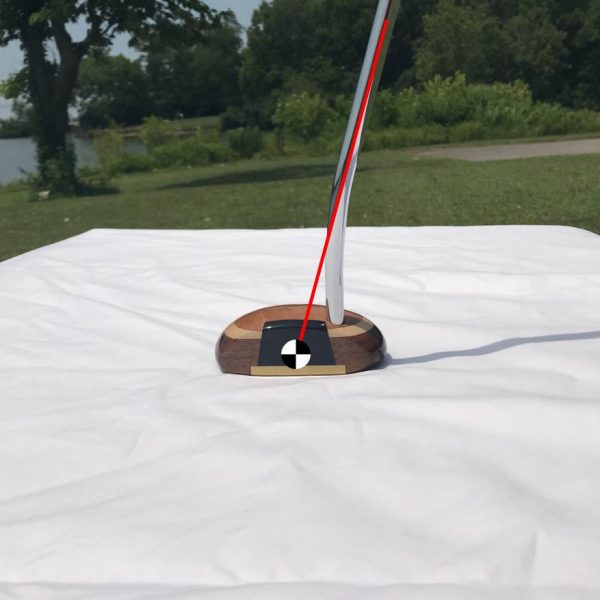
Face-balanced putter’s relationship between axis of shaft (red line) and putter CG
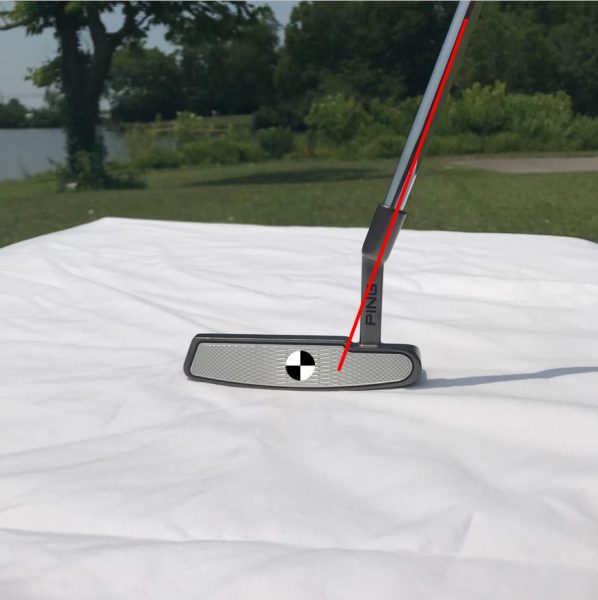
Ping Anser’s relationship between axis of shaft (red line) and putter CG
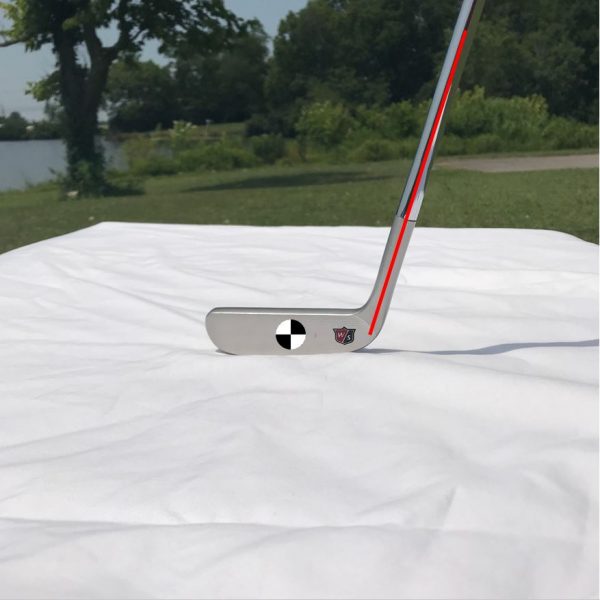
8802’s relationship between axis of shaft (red line) and putter CG
What does Toe Hang actually do?
In the interest of full disclosure, I would have to submit that there is a myriad of characteristics that make a certain putter perfect for a particular golfer. This article is a deep dive into just one of those topics. We have to assume the putter’s length, lie angle, loft, offset, static weight, swing weight, grip size, grip shape, etc. are already suited to the golfer. We also have to assume the putter fits the golfer’s eye, feels right, and inspires confidence. Assuming those have all been configured correctly, let’s address what toe hang can do for a golfer.
Let’s go back to our previous discussion about more toe hang encouraging more torqueing of the putter face. Ultimately, you need to ask yourself what you want to feel when swinging the putter, as toe hang will contribute a lot to how the golfer feels where the face of the putter is. A golfer who prefers a lot of toe hang will complain that he or she has no idea where the face is when swinging a face balanced putter. On the contrary, a golfer who prefers a face balanced putter will feel like he or she has to fight with the putter in order to square the face of a heel-shafted blade.
As a general rule, more toe hang will either encourage or better suit a stronger arc in the putting stroke. One of the more classic examples of this arrangement would be Ben Crenshaw’s fluid, swinging-a-door putting stroke matched to the iconic heel-shafted blade putter he so famously wielded over the years.
Putters in the vicinity of ¼ toe hang (probably most of which would be somehow related to the trusty Ping Anser) generally encourage or better suit a slight arc in the putting stroke. Examples of this setup are nearly endless, but arguably one of the more successful would be Brad Faxon, who holds the record for lowest putts per GIR in a PGA Tour season at 1.704.
Face-balanced putters (as you might have guessed) generally encourage or will better suit a straight-back, straight-through putting stroke. These types of putters will most often appear in the form of a mallet with a double bend shaft. This recipe is one that has been widely attributed to legendary instructor Dave Pelz and his teaching methodology.
What does all of this ultimately mean?
When you go shopping for a new flat stick, try out different amounts of toe hang and get a feel for how they engage your hands as you swing the putter. Ultimately, that’s what you’re paying attention to. Different amounts of toe hang will allow you to have a different feel for where the face of the putter is, which will have different effects on how you release the putter. This will affect both the location you strike the ball on the face as well as your face angle control, so having a poor match could adversely affect both your distance and directional control.
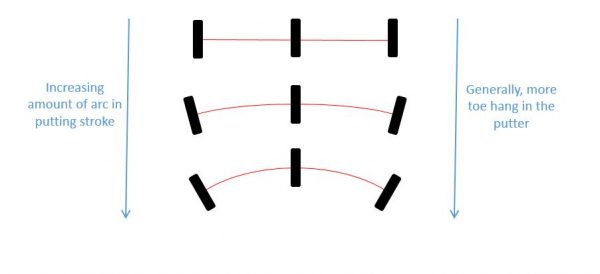
Different putting stroke paths and their general relationship with toe hang
There is no “one size fits all” answer for what works, but as I alluded to above, there are some general guidelines for where you can start. As a rule, the more arc you have in your stroke, the more toe hang you will likely prefer. With that being said, there are exceptions to every rule. While it’s generally true that an 8802 is a good match with a strong arc stroke (for example), there are also cases where a golfer’s natural strong arcing stroke might benefit from something with less toe hang. Placing the center of gravity of the putter closer to the axis of the shaft could possibly quiet the golfer’s hands during the putting stroke. This, of course, depends on whether your personal putting stroke needs correcting or simply complimenting.
Also, your typical miss patterns could indicate a mismatch between you and the toe hang in your putter. If you miss a lot of putts to the right (for a right-handed golfer), a putter with less toe hang might help you correct that. Obviously, the reverse of that might also help you if you miss to the left often.
In short, while there are some general guidelines to follow that serve as good starting points, there is no cookie-cutter answer for finding the right putter from you apart from a fitting with an experienced professional. And when you find the right recipe for YOU, stick with it. No two golfers are the same and no two putters are the same.
- LIKE716
- LEGIT65
- WOW23
- LOL12
- IDHT8
- FLOP14
- OB7
- SHANK54
19th Hole
Vincenzi’s 2024 Wells Fargo Championship betting preview: Tommy Fleetwood ready to finally land maiden PGA Tour title

The PGA Tour season ramps back up this week for another “signature event,” as golf fans look forward to the year’s second major championship next week.
After two weaker-field events in the Zurich Classic and the CJ Cup Byron Nelson, most of the best players in the world will head to historic Quail Hollow for one of the best non-major tournaments of the year.
Last season, Wyndham Clark won the event by four shots.
Quail Hollow is a par-71 measuring 7,521 yards that features Bermudagrass greens. The tree-lined, parkland style course can play quite difficult and features one of the most difficult three-hole stretches in golf known as “The Green Mile,” which makes up holes 16-18: two mammoth par 4s and a 221-yard par 3. All three holes have an average score over par, and water is in play in each of the last five holes on the course.
The field is excellent this week with 68 golfers teeing it up without a cut. All of the golfers who’ve qualified are set to tee it up, with the exception of Scottie Scheffler, who is expecting the birth of his first child.
Past Winners at Quail Hollow
- 2023: Wyndham Clark (-19)
- 2022: Max Homa (-8)
- 2021: Rory McIlroy (-10)
- 2019: Max Homa (-15)
- 2018: Jason Day (-12)
- 2017: Justin Thomas (-8) (PGA Championship)
- 2016: James Hahn (-9)
- 2015: Rory McIlroy (-21)
Key Stats For Quail Hollow
Strokes Gained: Approach
Strokes gained: Approach will be extremely important this week as second shots at Quail Hollow can be very difficult.
Total SG: Approach Over Past 24 Rounds
- Akshay Bhatia (+1.16)
- Tom Hoge (+1.12)
- Corey Conners (+1.01)
- Shane Lowry (+0.93)
- Austin Eckroat (+0.82)
Strokes Gained: Off the Tee
Quail Hollow is a long course on which it is important to play from the fairway. Both distance and accuracy are important, as shorter tee shots will result in approach shots from 200 or more yards. With most of the holes heavily tree lined, errant drives will create some real trouble for the players.
Strokes Gained: Off the Tee Past 24 Rounds:
- Ludvig Aberg (+0.73)
- Rory McIlroy (+0.69)
- Xander Schauffele (+0.62)
- Viktor Hovland (+0.58)
- Chris Kirk (+0.52)
Proximity: 175-200
The 175-200 range is key at Quail Hollow. Players who can hit their long irons well will rise to the top of the leaderboard.
Proximity: 175-200+ over past 24 rounds:
- Cameron Young (28’2″)
- Akshay Bhatia (29’6″)
- Ludvig Aberg (+30’6″)
- Sam Burns (+30’6″)
- Collin Morikawa (+30’9″)
SG: Total on Tom Fazio Designs
Players who thrive on Tom Fazio designs get a bump for me at Quail Hollow this week.
SG: Total on Tom Fazio Designs over past 36 rounds:
- Patrick Cantlay (+2.10)
- Rory McIlroy (+1.95)
- Tommy Fleetwood (+1.68)
- Austin Eckroat (+1.60)
- Will Zalatoris (+1.57)
Strokes Gained: Putting (Bermudagrass)
Strokes Gained: Putting has historically graded out as the most important statistic at Quail Hollow. While it isn’t always predictable, I do want to have it in the model to bump up golfers who prefer to putt on Bermudagrass.
Strokes Gained: Putting (Bermudagrass) Over Past 24 Rounds:
- Taylor Moore (+0.82)
- Nick Dunlap (+.76)
- Wyndham Clark (+.69)
- Emiliano Grillo (+.64)
- Cam Davis (+.61)
Course History
This stat will incorporate players that have played well in the past at Quail Hollow.
Course History over past 36 rounds (per round):
- Rory McIlroy (+2.50)
- Justin Thomas (+1.96)
- Jason Day (+1.92)
- Rickie Fowler (+1.83)
- Viktor Hovland (+1.78)
Wells Fargo Championship Model Rankings
Below, I’ve compiled overall model rankings using a combination of the five key statistical categories previously discussed — SG: Approach (27%), SG: Off the Tee (23%), SG: Total on Fazio designs (12%), Proximity: 175-200 (12%), SG: Putting Bermuda grass (12%), and Course History (14%).
- Wyndham Clark
- Rory McIlroy
- Xander Schauffele
- Shane Lowry
- Hideki Matsuyama
- Viktor Hovland
- Cameron Young
- Austin Eckroat
- Byeong Hun An
- Justin Thomas
2024 Wells Fargo Championship Picks
Tommy Fleetwood +2500 (DraftKings)
I know many out there have Tommy fatigue when it comes to betting, which is completely understandable given his lack of ability to win on the PGA Tour thus far in his career. However, history has shown us that players with Fleetwood’s talent eventually break though, and I believe for Tommy, it’s just a matter of time.
Fleetwood has been excellent on Tom Fazio designs. Over his past 36 rounds, he ranks 3rd in the field in Strokes Gained: Total on Fazio tracks. He’s also been incredibly reliable off the tee this season. He’s gained strokes in the category in eight of his past nine starts, including at The Masters, the PLAYERS and the three “signature events” of the season. Tommy is a golfer built for tougher courses and can grind it out in difficult conditions.
Last year, Fleetwood was the first-round leader at this event, firing a Thursday 65. He finished the event in a tie for 5th place.
For those worried about Fleetwood’s disappointing start his last time out at Harbour Town, he’s bounced back nicely after plenty of poor outings this season. His T7 at the Valero Texas Open was after a MC and T35 in his prior two starts and his win at the Dubai Invitational came after a T47 at the Sentry.
I expect Tommy to bounce back this week and contend at Quail Hollow.
Justin Thomas +3000 (DraftKings)
It’s been a rough couple of years for Justin Thomas, but I don’t believe things are quite as bad as they seem for JT. He got caught in the bad side of the draw at Augusta for last month’s Masters and has gained strokes on approach in seven of his nine starts in 2024.
Thomas may have found something in his most recent start at the RBC Heritage. He finished T5 at a course that he isn’t the best fit for on paper. He also finally got the putter working and ranked 15th in Strokes Gained: Putting for the week.
The two-time PGA champion captured the first of his two major championships at Quail Hollow back in 2017, and some good vibes from the course may be enough to get JT out of his slump.
Thomas hasn’t won an event in just about two years. However, I still believe that will change soon as he’s been one of the most prolific winners throughout his PGA Tour career. Since 2015, he has 15 PGA Tour wins.
Course history is pretty sticky at Quail Hollow, with players who like the course playing well there on a regular basis. In addition to JT’s PGA Championship win in 2017, he went 4-1 at the 2022 Presidents Cup and finished T14 at the event last year despite being in poor form. Thomas can return as one of the top players on the PGA Tour with a win at a “signature event” this week.
Cameron Young +3500 (DraftKings)
For many golf bettors, it’s been frustrating backing Cam Young this season. His talent is undeniable, and one of the best and most consistent performers on the PGA Tour. He just hasn’t broken through with a victory yet. Quail Hollow has been a great place for elite players to get their first victory. Rory McIlroy, Anthony Kim, Rickie Fowler and Wyndham Clark all notched their first PGA Tour win at Quail.
Throughout Cam Young’s career, he has thrived at tougher courses with strong fields. This season, he finished T16 at Riviera and T9 at Augusta National, demonstrating his preference of a tough test. His ability to hit the ball long and straight off the tee make him an ideal fit for Quail Hollow, despite playing pretty poorly his first time out in 2023 (T59). Young should be comfortable playing in the region as he played his college golf at Wake Forest, which is about an hour’s drive from Quail Hollow.
The 26-year-old has played well at Tom Fazio designs in the past and ranks 8th in the field in Strokes Gained: Total on those courses in his last 36 rounds. Perhaps most importantly, this season, Young is the best player on the PGA Tour in terms of proximity from 175-200 in the fairway, which is where a plurality and many crucial shots will come from this week.
Young is an elite talent and Quail Hollow has been kind to players of his ilk who’ve yet to win on Tour.
Byeong Hun An +5000 (FanDuel)
Byeong Hun An missed some opportunities last weekend at the CJ Cup Byron Nelson. He finished T4 and played some outstanding golf, but a couple of missed short putts prevented him from getting to the winning score of -23. Despite not getting the win, it’s hard to view An’s performance as anything other than an overwhelming success. It was An’s fourth top-ten finish of the season.
Last week, An gained 6.5 strokes ball striking, which was 7th in the field. He also ranked 12th for Strokes Gained: Approach and 13th for Strokes Gained: Off the Tee. The South Korean has been hitting the ball so well from tee to green all season long and he now heads to a golf course that should reward his precision.
An’s driver and long irons are absolute weapons. At Quail Hollow, players will see plenty of approach shots from the 175-200 range as well as some from 200+. In his past 24 rounds, Ben ranks 3rd in the field in proximity from 175-200 and 12th in proximity from 200+. Playing in an event that will not end up being a “birdie” fest should help An, who can separate from the field with his strong tee to green play. The putter may not always cooperate but getting to -15 is much easier than getting to -23 for elite ball strikers who tend to struggle on the greens.
Winning a “signature event” feels like a tall task for An this week with so many elite players in the field. However, he’s finished T16 at the Genesis Invitational, T16 at The Masters and T8 at the Arnold Palmer Invitational. The 32-year-old’s game has improved drastically this season and I believe he’s ready to get the biggest win of his career.
- LIKE7
- LEGIT2
- WOW0
- LOL0
- IDHT0
- FLOP0
- OB0
- SHANK0
19th Hole
Vincenzi’s LIV Golf Singapore betting preview: Course specialist ready to thrive once again

After another strong showing in Australia, LIV Golf will head to Sentosa Golf Club in Singapore looking to build off of what was undoubtedly their best event to date.
Sentosa Golf Club sits on the southern tip of Singapore and is one of the most beautiful courses in the world. The course is more than just incredible scenically; it was also rated 55th in Golf Digest’s top-100 courses in 2022-2023 and has been consistently regarded as one of the best courses in Asia. Prior to being part of the LIV rotation, the course hosted the Singapore Open every year since 2005.
Sentosa Golf Club is a par 71 measuring 7,406 yards. The course will require precise ball striking and some length off the tee. It’s possible to go low due to the pristine conditions, but there are also plenty of hazards and difficult spots on the course that can bring double bogey into play in a hurry. The Bermudagrass greens are perfectly manicured, and the course has spent millions on the sub-air system to keep the greens rolling fast. I spoke to Asian Tour player, Travis Smyth, who described the greens as “the best [he’s] ever played.”
Davis Love III, who competed in a Singapore Open in 2019, also gushed over the condition of the golf course.
“I love the greens. They are fabulous,” the 21-time PGA Tour winner said.
Love III also spoke about other aspects of the golf course.
“The greens are great; the fairways are perfect. It is a wonderful course, and it’s tricky off the tee.”
“It’s a long golf course, and you get some long iron shots. It takes somebody hitting it great to hit every green even though they are big.”
As Love III said, the course can be difficult off the tee due to the length of the course and the trouble looming around every corner. It will take a terrific ball striking week to win at Sentosa Golf Club.
In his pre-tournament press conference last season, Phil Mickelson echoed many of the same sentiments.
“To play Sentosa effectively, you’re going to have a lot of shots from 160 to 210, a lot of full 6-, 7-, 8-iron shots, and you need to hit those really well and you need to drive the ball well.”
Golfers who excel from tee to green and can dial in their longer irons will have a massive advantage this week.
Stat Leaders at LIV Golf Adelaide:
Fairways Hit
1.) Louis Oosthuizen
2.) Anirban Lahiri
3.) Jon Rahm
4.) Brendan Steele
5.) Cameron Tringale
Greens in Regulation
1.) Brooks Koepka
2.) Brendan Steele
3.) Dean Burmester
4.) Cameron Tringale
5.) Anirban Lahiri
Birdies Made
1.) Brendan Steele
2.) Dean Burmester
3.) Thomas Pieters
4.) Patrick Reed
5.) Carlos Ortiz
LIV Golf Individual Standings:
1.) Joaquin Niemann
2.) Jon Rahm
3.) Dean Burmester
4.) Louis Oosthuizen
5.) Abraham Ancer
LIV Golf Team Standings:
1.) Crushers
2.) Legion XIII
3.) Torque
4.) Stinger GC
5.) Ripper GC
LIV Golf Singapore Picks
Sergio Garcia +3000 (DraftKings)
Sergio Garcia is no stranger to Sentosa Golf Club. The Spaniard won the Singapore Open in 2018 by five strokes and lost in a playoff at LIV Singapore last year to scorching hot Talor Gooch. Looking at the course setup, it’s no surprise that a player like Sergio has played incredible golf here. He’s long off the tee and is one of the better long iron players in the world when he’s in form. Garcia is also statistically a much better putter on Bermudagrass than he is on other putting surfaces. He’s putt extremely well on Sentosa’s incredibly pure green complexes.
This season, Garcia has two runner-up finishes, both of them being playoff losses. Both El Camaleon and Doral are courses he’s had success at in his career. The Spaniard is a player who plays well at his tracks, and Sentosa is one of them. I believe Sergio will get himself in the mix this week. Hopefully the third time is a charm in Singapore.
Paul Casey +3300 (FanDuel)
Paul Casey is in the midst of one of his best seasons in the five years or so. The results recently have been up and down, but he’s shown that when he’s on a golf course that suits his game, he’s amongst the contenders.
This season, Casey has finishes of T5 (LIV Las Vegas), T2 (LIV Hong Kong), and a 6th at the Singapore Classic on the DP World Tour. At his best, the Englishman is one of the best long iron players in the world, which makes him a strong fit for Sentosa. Despite being in poor form last season, he was able to fire a Sunday 63, which shows he can low here at the course.
It’s been three years since Casey has won a tournament (Omega Dubai Desert Classic in 2021), but he’s been one of the top players on LIV this season and I think he can get it done at some point this season.
Mito Pereira +5000 (Bet365)
Since Mito Pereira’s unfortunate demise at the 2022 PGA Championship, he’s been extremely inconsistent. However, over the past few months, the Chilean has played well on the International Series as well as his most recent LIV start. Mito finished 8th at LIV Adelaide, which was his best LIV finish this season.
Last year, Pereira finished 5th at LIV Singapore, shooting fantastic rounds of 67-66-66. It makes sense why Mito would like Sentosa, as preeminent ball strikers tend to rise to the challenge of the golf course. He’s a great long iron player who is long and straight off the tee.
Mito has some experience playing in Asia and is one of the most talented players on LIV who’s yet to get in the winner’s circle. I have questions about whether or not he can come through once in contention, but if he gets there, I’m happy to roll the dice.
Andy Ogletree +15000 (DraftKings)
Andy Ogletree is a player I expected to have a strong 2024 but struggled early in his first full season on LIV. After failing to crack the top-25 in any LIV event this year, the former U.S. Amateur champion finally figured things out, finished in a tie for 3rd at LIV Adelaide.
Ogletree should be incredible comfortable playing in Singapore. He won the International Series Qatar last year and finished T3 at the International Series Singapore. The 26-year-old was arguably the best player on the Asian Tour in 2023 and has been fantastic in the continent over the past 18 months.
If Ogletree has indeed found form, he looks to be an amazing value at triple-digit odds.
- LIKE3
- LEGIT3
- WOW1
- LOL2
- IDHT0
- FLOP2
- OB0
- SHANK0
Opinion & Analysis
Ryan: Lessons from the worst golf instructor in America

In Tampa, there is a golf course that boasts carts that do not work, a water range, and a group of players none of which have any chance to break 80. The course is overseen by a staff of crusty men who have succeeded at nothing in life but ending up at the worst-run course in America. However, this place is no failure. With several other local courses going out of business — and boasting outstanding greens — the place is booked full.
While I came for the great greens, I stayed to watch our resident instructor; a poor-tempered, method teacher who caters to the hopeless. At first, it was simply hilarious. However, after months of listening and watching, something clicked. I realized I had a front-row seat to the worst golf instructor in America.
Here are some of my key takeaways.
Method Teacher
It is widely accepted that there are three types of golf instructors: system teachers, non-system teachers, and method teachers. Method teachers prescribe the same antidote for each student based on a preamble which teachers can learn in a couple day certification.
Method teaching allows anyone to be certified. This process caters to the lowest caliber instructor, creating the illusion of competency. This empowers these underqualified instructors with the moniker of “certified” to prey on the innocent and uninformed.
The Cult of Stack and Jilt
The Stack and Tilt website proudly boasts, “A golfer swings his hands inward in the backswing as opposed to straight back to 1) create power, similar to a field goal kicker moving his leg in an arc and 2) to promote a swing that is in-to-out, which produces a draw (and eliminates a slice).”
Now, let me tell you something, there is this law of the universe which says “energy can either be created or destroyed,” so either these guys are defying physics or they have no idea what they are taking about. Further, the idea that the first move of the backswing determines impact is conjecture with a splash of utter fantasy.
These are the pontifications of a method — a set of prescriptions applied to everyone with the hope of some success through the placebo effect. It is one thing for a naive student to believe, for a golf instructor to drink and then dispel this Kool-Aid is malpractice.
Fooled by Randomness
In flipping a coin, or even a March Madness bet, there is a 50-50 chance of success. In golf, especially for new players, results are asymmetric. Simply put: Anything can happen. The problem is that when bad instructors work with high handicappers, each and every shot gets its own diagnosis and prescription. Soon the student is overwhelmed.
Now here’s the sinister thing: The overwhelming information is by design. In this case, the coach is not trying to make you better, they are trying to make you reliant on them for information. A quasi Stockholm syndrome of codependency.
Practice
One of the most important scientists of the 20th century was Ivan Pavlov. As you might recall, he found that animals, including humans, could be conditioned into biological responses. In golf, the idea of practice has made millions of hackers salivate that they are one lesson or practice session from “the secret.”
Sunk Cost
The idea for the worst golf instructor is to create control and dependency so that clients ignore the sunk cost of not getting better. Instead, they are held hostage by the idea that they are one lesson or tip away from unlocking their potential.
Cliches
Cliches have the effect of terminating thoughts. However, they are the weapon of choice for this instructor. Add some hyperbole and students actually get no information. As a result, these players couldn’t play golf. When they did, they had no real scheme. With no idea what they are doing, they would descend into a spiral of no idea what to do, bad results, lower confidence, and running back to the lesson tee from more cliches.
The fact is that poor instruction is about conditioning players to become reliant members of your cult. To take away autonomy. To use practice as a form of control. To sell more golf lessons not by making people better but through the guise that without the teacher, the student can never reach their full potential. All under the umbrella of being “certified” (in a 2-day course!) and a melee of cliches.
This of course is not just happening at my muni but is a systemic problem around the country and around the world, the consequences of which are giving people a great reason to stop playing golf. But hey, at least it’s selling a lot of golf balls…
- LIKE21
- LEGIT2
- WOW0
- LOL4
- IDHT1
- FLOP4
- OB1
- SHANK25
-

 19th Hole2 weeks ago
19th Hole2 weeks agoJustin Thomas on the equipment choice of Scottie Scheffler that he thinks is ‘weird’
-

 19th Hole2 weeks ago
19th Hole2 weeks ago‘Absolutely crazy’ – Major champ lays into Patrick Cantlay over his decision on final hole of RBC Heritage
-

 19th Hole2 weeks ago
19th Hole2 weeks agoLET pro gives detailed financial breakdown of first week on tour…and the net result may shock you
-

 19th Hole7 days ago
19th Hole7 days agoGary Player claims this is what ‘completely ruined’ Tiger Woods’ career
-

 19th Hole21 hours ago
19th Hole21 hours agoReport: LIV star turns down PGA Championship invite due to ‘personal commitments’
-

 Whats in the Bag1 week ago
Whats in the Bag1 week agoTeam McIlowry (Rory McIlroy, Shane Lowry) winning WITBs: 2024 Zurich Classic
-

 19th Hole3 weeks ago
19th Hole3 weeks agoTaylorMade signs 15-year-old AJGA Rolex Junior Player of the Year to an NIL contract
-

 Equipment1 week ago
Equipment1 week agoGolf fans left surprised by LIV’s choice of course for its 2024 individual championship event



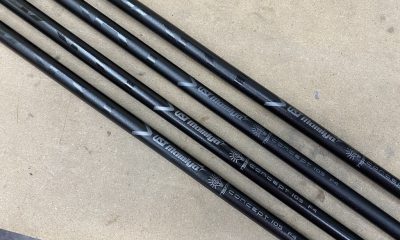





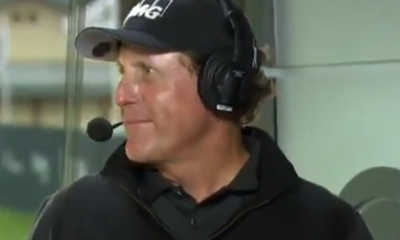

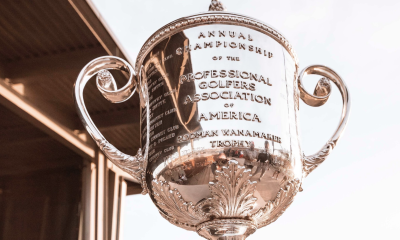

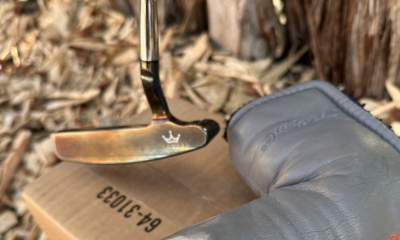









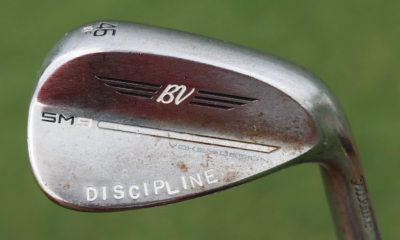







PBB
Jun 25, 2020 at 2:19 pm
Backwards. Full toe hang putters want to close on the backswing and open on the follow through. Better for straight back / straight through strokes.
Face balanced putters want to open on the backswing and close on the follow through. Better for strong arc putters.
A. Paul McDonough
May 30, 2021 at 1:30 pm
You are CORRECT about Toe Hang Putters closing, Face to Path, in the Backstroke and Opening Face to Path on Forward Stroke.
However, Face Balanced Putters stay Square to Path Backwards and Forward.
An “Arc Stroke” Player will Pull, and/or Hook Putts with a Face Balanced Putter.
A “Straight Path” Player will be able to get away with minimal Toe Flow, but TOO MUCH Toe Flow will lead to Push and/or Slice Putts.
Bruce
May 11, 2019 at 1:35 pm
re: If the toe of the putter is pointing at 7:30, that is generally referred to as 1/4 toe hang.”
If 9 o’clock is face balanced and 6 o’clock is toe balanced, then 7:30 os 1/2 toe hang!
Tee-Bone
Sep 5, 2018 at 2:19 pm
I’m no scientist, but its pretty obvious that as the shaft is swung back, the cg, if not in-line with the path of that shaft, will want to stay behind. Meaning, a heel-shafted putter wants to CLOSE going back, not OPEN. Its a nice story to sell putters, though.
joro
Sep 1, 2018 at 3:18 pm
And yet they still stick by that old thinking. The fact is the Putt is going to go where the face is facing regardless of your stroke, so does it really matter if you are a swinging gate or back and through ? Watch on TV when they show from behind and you see by the set up where the face is pointing and the ball will go there regardless of the stroke, aim left, the ball goes left.
Rich
Aug 14, 2018 at 7:58 pm
I’m a straight back and thru stroke guy and use a mallet and at times a 8802 and haven’t changed my stroke ,but the 8802 has a super stroke grip and that helps..
Geohogan
Aug 22, 2018 at 8:37 pm
Super stroke grip, increases counter weighting ie lowers swing weight
and thereby less sensitive to the head, which makes it easier, more natural to control the stroke.
Geohogan
Aug 22, 2018 at 8:40 pm
Guessing your 8802 with super stroke grip is B10-C4 swing weight.
Chuck
Aug 10, 2018 at 3:28 pm
In the lead photo, what is the putter that is second from the right?
Rusty Trombone
Aug 3, 2018 at 9:27 pm
I went from a face balanced Musty Putter, to the Ping sigma G Tyrone, to the Scotty Cameron 5.5m, then to my dad’s old Taylormade (lots of toe hang) and started putting lights out with it. Just received the Taylormade TP Soto today, and although it doesn’t have the same plastic pure roll insert as my dad’s, (it’s got a metal “milled insert”) it has similar toe hang, and look forward to testing it out. Definitely want to try the SAM thing another poster mentioned.
stuart burley
Jul 28, 2018 at 10:15 am
The explanation of the COG in relation to the shaft is very good. Fact is though that the opening and closing and clubface torque have been proven to be the opposite. Good golfers aim slightly left and hold the clubface off through impact (negative gamma torque). Poor putters aim slightly right and over rotate during impact (positive gamma rotation). This is easier to do with a face balanced putter due to the removal of clubface torque.
shawn
Jul 29, 2018 at 10:35 pm
No, you are wrong about the COG. What Peter has shown is incomplete because you must also consider the COG of the putter head itself which may be well behind the “sweet spot” shown on the putter face. You must determine where the red line axis intersects the putter head to fully understand putter mechanics. And if you are applying torque to the putter you are incompetent.
Geohogan
Jul 29, 2018 at 11:24 pm
Whether a pro or am, impact between the putter face and the ball is
one, one thousandths of a second. There is no gamma rotation in one, one thousandths of a second, positive or negative.
Stop perpetuating mythology.
RBImGuy
Jul 27, 2018 at 8:27 am
I am a great putter and putt well with any sort of putter.
its the Indian not the bow
billwill
Jul 27, 2018 at 1:45 pm
So yer an “Indian”? Which tribe… or is it just a lot of sitting bull?
Geohogan
Jul 27, 2018 at 4:42 pm
Cant fool us, RBiMguy,
welcome to Golfwrx, Most Interesting Man in the World.
https://www.pinterest.ca/pin/230387337164228759/
Harv
Jul 26, 2018 at 7:39 pm
I got toe hang… but I just use a nail clipper…
HDTVMAN
Jul 25, 2018 at 10:50 pm
Another very important part of the putting decision is the grip. Thin, thick, flat, round, hard, soft…there are no right or wrongs, whatever you like.
Socrates
Jul 25, 2018 at 9:24 pm
Seems like a regurgitation of mythology with no real data to substantiate the claims. Plenty of players on Tour (I’ll use Tour players since they are the best putters out there) who use face balanced putters and have an arcing stroke. And plenty that use a toe hang putter that are SBST. Reminds me of how people thought they knew how to make the ball curve until the “new” ball flight rules told us what really happens.
Caroline
Jul 25, 2018 at 11:27 pm
Nothing, absolutely nothing is more important in golf, pitches, chips, putting..then hand eye coordination…pros have so much of it that trying to do what they do is impossible unless you have that coordination yourself. For us amateurs golf is an adventure every time we step on the first tee. Amateurs that improve and get better only do so because they stick with what ever they found that gets them into the hole. Sadly most amateurs are at the mercy of what ever the next swing,putt, chip article some “golf” instructor has published this month. If you find a way that gets it into the hole that is your secret.
Cris Kennedy
Jul 25, 2018 at 8:36 pm
The only putter you want is the one you paid SO MUCH MONEY FOR that you can never ever change to something else because, after all, you spent WAY MORE MONEY than you can ever justify, or even recover from financially. This way…you can never change putters. It FORCES you to learn how to use that putter; i.e., you’ll finally learn how to putt and not keep thinking, “….maybe my problem I need the latest and greatest (different) putter that___________uses on tour……!!
Cameron Diego
Jul 26, 2018 at 11:09 am
Chris, you are so right. I’ve been making payments on my Scotty Cameron putter for the last fifteen years. It is almost paid off (only have five more years to go) and in the last two years, I have only three-putted once.
Terry Porvin
Jul 25, 2018 at 8:04 pm
There may be an error in the 2nd to last paragraph of the article. From my understanding, if a right handed golfer is missing putts right, he/she may need more to hang to square up the face & vise versa.
Scott S
Jul 27, 2018 at 7:59 am
Terry- When I read that I thought the same thing. More toe hang would create a greater amount of putter face closing during the stroke would it not? The only thing I could think of was perhaps with less toe hang the putter would not open up as much to begin with and effectively reduce overall opening/closing of the face. I would love to hear a greater explanation of this or a correction of what was written.
A. Paul McDonough
May 30, 2021 at 1:44 pm
Terry, Toe Hang Putters CLOSE – Face to Path – BACK and OPEN – FtP – going Forward. Coming from Inside to Square to Inside (Arc Stroke) with a “Closing” Face would produce either Pulls and/or Hooking Putts.
Face Balanced stay Square to Path.
A “Straight Line” Stroke Player can get away with minimal Toe Flow, too much would lead to Push and/or Slice Putts.
JR
Jul 25, 2018 at 2:44 pm
I find reading the putt correctly helps me make more putts.
billwill
Jul 27, 2018 at 1:44 pm
No kidding…. 😮
Joe Perez
Jul 25, 2018 at 2:15 pm
Wonderful article, but I still can’t figure out why sometimes I prefer a face-balanced mallet and other times, one with a lot of toe-hang. ????
Geohogan
Jul 28, 2018 at 12:53 am
“Change is as good as a rest?”
When we change it up, it stimulates our brain.
Its not toe hang or not toe hang, its the variety that increases focus and we do better .. until we need another fix.
Neurologists say, to change the route home from work every day. It stimulates neurons. Change in our golf prevents atrophy.
Billy
Apr 19, 2019 at 5:27 am
You hit the nail on the head. I just bay’d an O Works 1W and boy am I making putts!
CJ
Jul 25, 2018 at 1:50 pm
While there are always typical negative responses, most poor putters can’t read greens. Using arc style trainer and putting rh only for rh players helped me tremendously. Thanks for the article OP.
BL
Jul 25, 2018 at 12:34 pm
Toe hang can be very misleading. See: Bullseyes.
dtrain
Jul 25, 2018 at 12:22 pm
So what does this article prove that I haven’t seen 1000 times before? How exactly is this a “deep dive” More like sticking your toe in the kiddie pool. How about some serious testing, with actual golfers?
Peter Schmitt
Jul 25, 2018 at 11:50 am
Thanks for the discussion, folks. There’s a lot to unpack here and frankly there wasn’t enough room to talk about concepts such as toe up, face balanced at impact, and the like. This is intended to serve as a 101-level discussion to cover the “traditional” spectrum of one aspect of putter design. This should aid in having an informed discussion with a fitter, which IMO is the proper conclusion of the article. Go get a proper fitting with a qualified individual.
Don
Jul 25, 2018 at 2:58 pm
You also failed to mention how the actual “connection point” of the shaft to the putter head affects things. For example, your first picture (the one showing the face-balanced putter with the axis of the shaft pointing directly at the impact sweet spot) would actually create torque (twist) at the moment of impact because even though the axis of the shaft is pointed at the sweet spot, the shaft “connects” toward the heel. Now, contrast this to a center-shafted putter that has the exact same axis of the shaft but that connects to the putter head with no goose-neck. It would not twist when impacting the ball because it connects at the point where the sweet spot actually is. From a “physics” standpoint, a center-shafted putter would seem to be more ideal even though the axis of the shaft would be exactly the same as one with a goose-neck.
engineer bob
Jul 26, 2018 at 4:20 pm
Why is my scientifically valid comment being held for moderation?
Harv
Jul 26, 2018 at 7:38 pm
…. because if you’re too smart they will delete your comments because the don’t want the gearheads to blow up their heads…
Jimmie
Jul 25, 2018 at 9:16 am
How about putters that are perfectly 360 degree balanced, which means either no toe hang or any toe hang you desire. It is ideal as there is no bias and perfect feel. I got one from ebay P&si-Egos putter.
PT
Aug 1, 2018 at 9:00 pm
Yeah but you notice on their website that they have no video examples of anybody actually making any putts with the putter? Nobody! But they have videos of everybody else missing.
QB
Jul 25, 2018 at 9:02 am
You neglected to mention toe up putters, which point to 12 noon! 12 o’clock toe hang allows the face to remain square throughout the stroke, they’re nearly impossible to pull or push. Been bagging one for a couple years now and changed my game. Love my Edel brick but I believe odyssey came out with a line of toe up recently as well.
Jimmie
Jul 25, 2018 at 12:16 pm
I think Odyssey introduced a toe-down putter… just like Axis 1.
Antonio
Jul 25, 2018 at 3:16 am
Great article, thanks!
However I do not agree on the conclussion. By own experience If you tend to miss right a more toe Hung putter will help you close the face at impact and bring it more square, provided of course that you have and arc putter swing as you mentioned.
Scott S
Jul 27, 2018 at 8:04 am
Agreed!
Jim McPherson
Jul 25, 2018 at 1:48 am
So what is the consensus on putter fittings? Worth it?
Or is it all about rolling what appeals to the eye and then putting in the practice?
HDTVMAN
Jul 25, 2018 at 10:47 pm
I stress to my customers, before buying a putter, have a PGA Professional go thru the SAM, Science In Motion, program. It’s 90 minutes and $50 at our shop, and well worth it. It’s used at the Callaway Performance Center and TM’s Kingdom, and will show you your arc & strike angle, helping you to pick out the correct putter. We allow customers to compare their current putter to whatever putter on the floor that they are considering purchasing. Best $50 you will spend.
engineer bob
Jul 24, 2018 at 9:57 pm
… putter shaft axis… putter center of gravity… torque… moment… moment arm.… OK, stop here!!!
The table top test for toe hang is good, but let’s complicate it with some simple science.
Hold the top of your putter grip between the finger and thumb and twirl the hanging putter. If the shaft and spin axis coincide, the putter is face balanced. If the shaft rotates outside of the spin axis and wobbles, it’s not face balanced. (p.s. the vertical spin axis is called the longitudinal gravitational axis 😮 ).
David
Jul 24, 2018 at 9:21 pm
Check out the videos from the guys at Directed Force putters if you want to see what a crock “face-balanced” putters are. They absolutely, positively do not stay “square the the line” in any way, shape or form.
No I don’t work for Directed Force.
Yes, I bought one.
No, I no longer use it.
But, hey, let’s at least TRY to get the science right….
gif
Jul 24, 2018 at 9:59 pm
Are you a “feeel” putter?
Geohogan
Jul 24, 2018 at 10:40 pm
What if a putter did stay square to the line?
Putter ball contact is 1/1000 second for 1/4 inch.
That is all she wrote.
…so whether putter face stays square after impact is meaningless.
It is just more marketing BS, like oversize grips.
Check out the putters used by two of the greatest putters who ever lived, Bobby Jones and Bobby Locke.
Check out their putters.
gif
Jul 25, 2018 at 12:12 am
But you don’t realize that a putter represents a golfer’s fhallic symbol… his masculinity on the greens as he bravely putt-putts the ball into the hole… ploop 😮
acew/7iron
Jul 24, 2018 at 8:51 pm
Funny you mention big grips…I kept inching towards adding larger and larger ones until one day I realized I could not control distance or direction at all. Got a small grip and back to lagging them close or making them from time to time.
Geohogan
Jul 24, 2018 at 10:33 pm
ace, you werent adding larger and larger grips, but rather adding more and more weight to the butt end of the club. Some oversize grips will be 75 grams heavier than std(50 grams). Thats serious reduction in swing weight, maybe from D2 to C0? Serious reduction in clubhead feel.
IMO, adjustable counter weights is the way to go with putters. Its been proven that performance improves (up to 30 days) when we make changes; and if you believe a change will make a difference for the better (placebo effect), there is 60% chance you will improve.
gif
Jul 25, 2018 at 12:17 am
75 grams minus 50 grams = 25 grams… almost 1 ounce… insignificant…. and putter swingweight is irrelevant to a tiny putting movement. You can adjust to any putter size, shape, weight if you practice enough like the pros do.
Geohogan
Jul 26, 2018 at 7:50 am
Some oversize grips will be 75 grams heavier than std(50 grams
75+50=125 grams
Geohogan
Jul 24, 2018 at 7:51 pm
Messing around with an old Powerbilt, Model 57 blade putter not unlike Bobby Jones, Calamity Jane. 33.5 inches long, B 4 swing weight. Calamity Jane was B8, if reference I found is correct.
So although complete toe hanger(6 oclock), the counter balance puts so much weight in the hands, rather than the putter head,
that the face is very controllable.
Makes me think that counter balancing may be the reason for the fad to go to oversize grips. It must reduce Swing weight by at least 10 SW points , to add 50+ grams to the handle, with no compensation to the head.
I’ll bet if golfers maintained swing weight when they put oversize grips on their clubs the fad would go away. ie. its counter balancing resulting in significantly lower SW, that gives more clubhead control, not fatter grips.
gif
Jul 25, 2018 at 12:20 am
Those old 1-iron shaped vintage putters were used in the days of the “stymie”… where you had to loft your ball over your opponents ball to get to the hole… without contacting his ball…!!!
Geohogan
Jul 26, 2018 at 8:38 am
Many golfers today use putters with 6-10 degrees of loft and dont do it because of stymies. For one thing it allows forward lean or hands ahead and still maintain loft to get the ball rolling.
How much loft is remaining if putter has 2 degrees of loft and hands are ahead at impact?
Geohogan
Jul 26, 2018 at 2:13 pm
https://www.youtube.com/watch?v=_TCObKqRwtQ
1:20
Ben hogan , stymied, using an L Wedge?